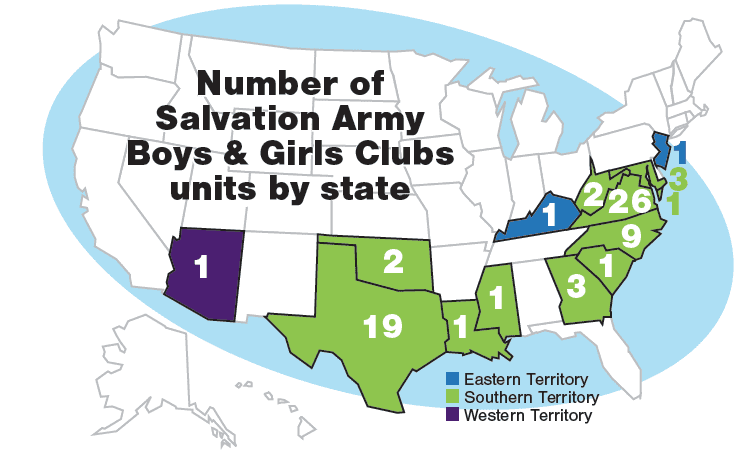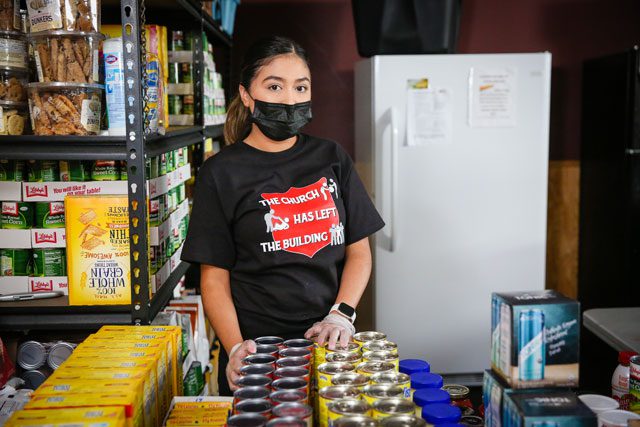A partnership between two powerful brands benefits thousands of children in the U.S.

By Karen Gleason –
A partnership between The Salvation Army and the Boys & Girls Clubs of America (BGCA) thrives in the Southern Territory, where Major Pete Costas once served as the Army’s national liaison to that organization.
“It’s all about the kids and meeting them just where they are,” said Costas, area commander for Wake and Lee Counties in North Carolina. “Or as former Salvation Army General John Gowans said, ‘fish where the fish are.’”
BGCA is a national organization of local chapters that provide after-school programs. It is tax-exempt and partially funded by the federal government, with headquarters in Atlanta and regional offices in Chicago, Dallas, Atlanta, New York City and Los Angeles. The clubs serve millions of children at thousands of clubs, including locations in all 50 states, Puerto Rico and the Virgin Islands, on U.S. military installations and on Native American lands.
Costas remains passionate about the partnership, as is Mark Jeffrey, current national liaison and Southern territorial Salvation Army Boys & Girls Clubs program director.

“The pond to go fishing in is quite large,” Jeffrey said. “This is the main benefit of the partnership from a missional standpoint. The opportunity is there for kids to cross over into the corps.”
The Southern Territory has 76 Salvation Army Boys & Girls Club units, the Eastern Territory has two (Lexington, Ky. and Newark, N.J.) and the West has one (Yuma, Ariz.). Outside the South, Salvationists often don’t know these clubs exist.
According to Jeffrey, in 2013 the 76 units in the South served a total of 60,545 children throughout the year. Of those, 24,623 were regular members and 35,922 were community outreach kids who participated but didn’t become members.

“The national Boys & Girls Clubs of America is the fastest growing youth serving agency in America,” Jeffrey said. The Salvation Army Boys & Girls Clubs are also growing, in recent years adding about one to two clubs annually.
The secret to the success in the South is simple but potent: leadership. Years ago the Army’s leaders there caught the vision of what this partnership could accomplish and worked to develop it. Successive leadership kept the momentum going.

While traditional Salvation Army after-school and homework clubs attract community children—some of whom are then linked with other Army youth programs—it’s hard to compete with the appeal of a Boys & Girls Club that is available several days a week.
Jeffrey said he is asked why The Salvation Army can’t run these clubs on its own. His response: Why would we?
According to Jeffrey, a major benefit of the partnership is the use of the BGCA programming—it’s cutting-edge, research-based and outcome-driven. “It’s nothing we can produce at that level,” he said.
While The Salvation Army runs many different programs for people of all ages and varying needs, the BGCA directs all resources to youth programming.
The Salvation Army Boys & Girls Clubs are similar in most ways to the regular BGCA, which charters them under the terms of a national agreement signed in 1960. According to Lorraine Orr, senior vice president of field operations for the national organization, this agreement is updated every couple of years to make sure it meets current needs. In addition, audits are regularly performed and an annual partnership meeting takes place.
The regular Boys & Girls Clubs operate under five core program areas: Education and Career Development, Character and Leadership Development, Health and Life Skills, The Arts, and Sports, Fitness and Recreation. The mission statement is “to enable all young people, especially those who need us most, to reach their full potential as productive, caring, responsible citizens.”

The Salvation Army adds a sixth tier to its clubs: Spiritual Development.
“From a missional standpoint, we are meeting both the goal of the Boys & Girls Clubs and that of The Salvation Army, to preach the gospel of Jesus Christ and to meet human needs in his name without discrimination,” Jeffrey said. “The clubs give us the opportunity to spread the gospel to kids and their families.”
From a business perspective, the partnership is also advantageous. Participants pay a yearly membership fee, sometimes as low as $20. According to Jeffrey, the club raises the money it needs, and is managed by a volunteer advisory board with a professional staff of trained personnel. National data from 2013 shows $130,883 in membership dues from all The Salvation Army Boys & Girls Clubs collectively. Money from the national organization to The Salvation Army Boys & Girls Clubs totalled $1.76 million.
According to Orr, the national BGCA receives an allocation from the Office of Justice of up to $23 million annually. Individual clubs apply for funding for specific programs, and the volunteer advisory councils work to raise awareness and resources. In some locations, the Army’s thrift stores provide an annual allocation to the clubs.

This doesn’t include the professional services the BGCA provide in strategic planning, resource development, daily operations, staff breakdown, and even appropriate pay rates depending on the area. When a Salvation Army club wants support from the national organization, it can contact the club liaison specialist or the director of organizational development, who visits clubs four times a year or more to provide mentoring services, board and council member training, and strategic planning.
“The Boys & Girls Club partnership is a no-brainer,” Costas said. “Salvation Army officers and employees receive management and fundraising training on a different level.”
Costas believes a main benefit of the partnership is the standards it provides—professional standards for leadership and hiring. Once those are established, the program has longevity and sustainability.
“It forces us at the local level to maintain standards of operation with oversight by a national organization whose only business is the running of these clubs,” Costas said.
Adding to the the clubs’ success is the leadership structure. Each club has an executive director or chief professional officer who has no other duties than those pertaining to the club.
“The negative—if there is one—is when [Salvation Army] leadership doesn’t see the benefit of the partnership or doesn’t understand how the organization works,” Jeffrey said.
Costas noted that sometimes Army officers are afraid that the Boys & Girls Clubs of America are running their programs, instead of recognizing the benefit of teaming up with another national youth agency.
“The Salvation Army and the Boys & Girls Clubs of America—these are two of the most powerful brands in the country,” Orr said. “This can be a really unique partnership. The key to its success is the vision of the leaders.”
______________________________
Local Salvation Army leadership can contact Mark Jeffrey (mark_jeffrey@uss.salvationarmy.org), Boys & Girls Club of America national liaison, for more information on forming a club in your community.












